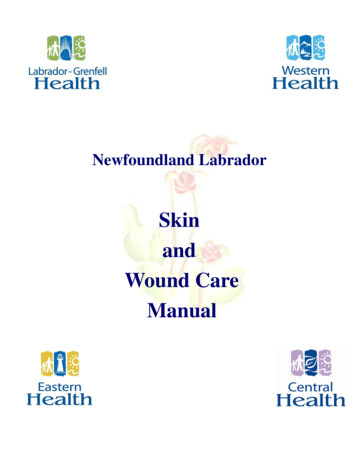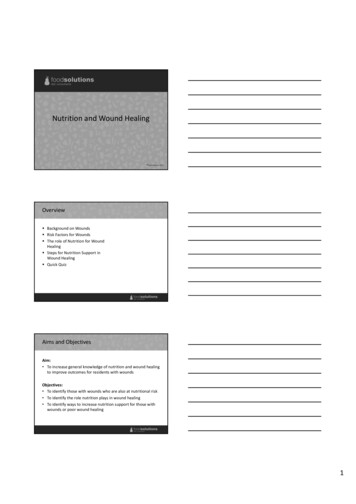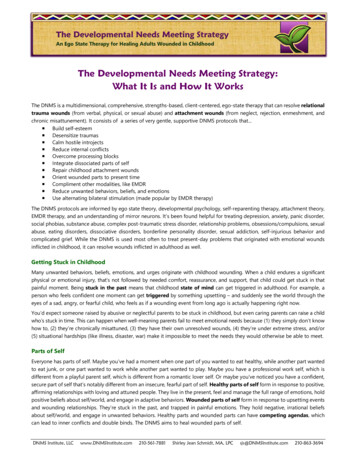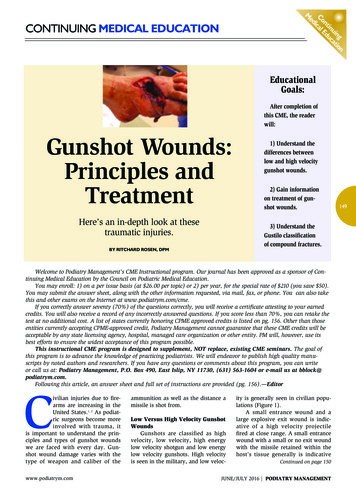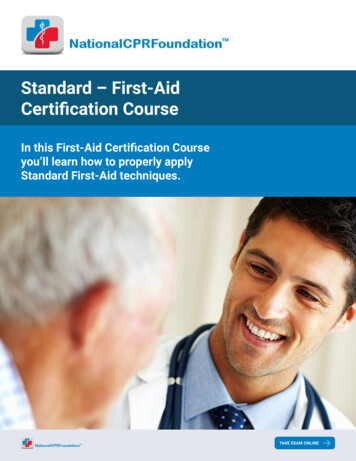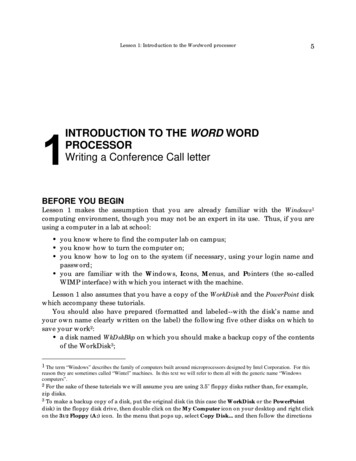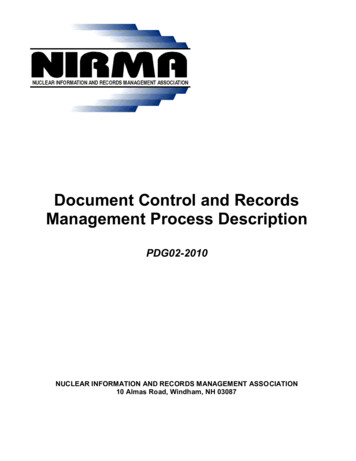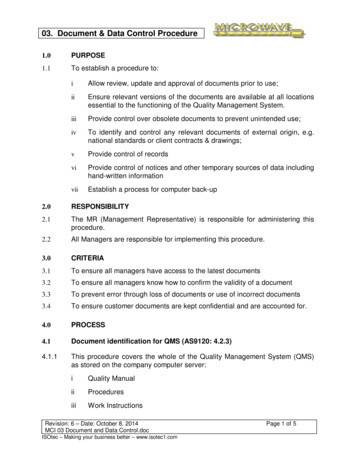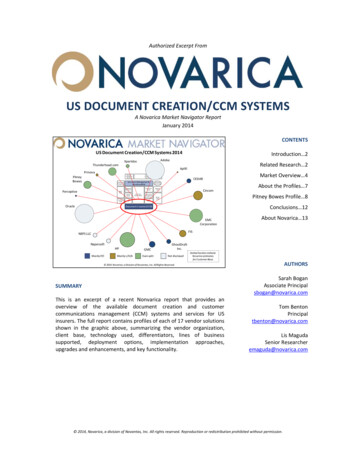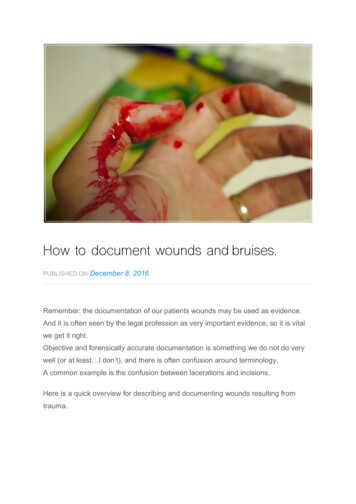
Transcription
How to document wounds and bruises.PUBLISHED ON December 8, 2016Remember: the documentation of our patients wounds may be used as evidence.And it is often seen by the legal profession as very important evidence, so it is vitalwe get it right.Objective and forensically accurate documentation is something we do not do verywell (or at least I don’t), and there is often confusion around terminology.A common example is the confusion between lacerations and incisions.Here is a quick overview for describing and documenting wounds resulting fromtrauma.
Bruises:A bruise results from the application of blunt force to the skin surface. Bloodinfiltrates the surrounding tissues from vessels ruptured during the impact.Bruises may become more pronounced hours, or even day after they were inflictedas blood diffuses closer to the skins surface.The shape of the bruise will often be affected by gravity as it ages. Sometimes alarge bruise around the eye and cheek may have ‘gravitated’ from an initial injury tothe scalp.As a rule, the larger the bruise, the longer it will take to subside. This may range fromdays to weeks.It is very difficult to estimate the age of a bruise.As the extravagated red blood cells near the surface are reabsorbed the initial redblue or purple-black of a fresh bruise, the colour may shift to a bluish-green or a mixof browns and yellows.Bruising with yellow colouration present can be considered at least 18–24 hours old.Bruising does not usually eventuate from any injury post mortem as there is nopressure within the vessels to spread blood.Petechiae are pinhole sized haemorrhages on the skin that may be produced bymechanical trauma, constriction of clothing, or suction (as in the love bite).Petechiae do not blanch when pressed.Petechiae may also be observed on serous membranes or conjunctivae and may beassociated with mechanical asphyxia.Importantly, petechiae may also be caused by medically related problems such assepsis.Purpura are larger and more irregular than petechiae. They are often seen in theelderly who have an increased haemorrhagic tendency.Ecchymoses are larger still, and blotchy in appearance. They are usually caused bya physiological mechanism and the word should be avoided when describingwounds.
Haematoma occurs when blood collects under the skin surface rather than diffusinginto the tissues.Lacerations:Lacerations result when a direct blunt force or shearing blow results in the fullthickness splitting of the skin.Lacerations have ragged edges (or margins) that are often bruised.Lacerations may contain foreign particles such as dirt or grit, or glass which shouldbe documented.Sometimes (particularly on scalp wounds) the laceration may have split the skin in astraight (i.e. not ragged) edge, but remember, if the injury was caused by bunt directforce, it is a laceration.Lacerations are rarely self-inflicted due to the significant pain that accompanies theirproduction.Incisions:Incisions are caused by the sharp edge of a cutting instrument such as a knife ortool or the sharp edge of broken glass (but remember, a thrown bottle that breaksover someone’s head will more likely result in lacerations than incisions.)Incisions have straight edges with little soiling or contamination and are oftenlonger than their depth.If deep they may result in profuse bleeding.If they cross Langer’ cleavage lines1 , the resulting wound may gape.Stab wounds:Stab wounds penetrate with a depth greater than their length. Can be caused by alarge variety of objects resulting in differing appearances at the skin level.
A double edged blade, for example may result in an elliptical wound whilst a bladelike a kitchen knife may result in a triangular or fish-tail wound due to its non-cuttingback edge.Importantly, due to the elasticity of tissue, the actual surface length of the stabwound is a poor indicator of the actual width of the instrument that caused it (and ifthe blade entered the skin at an angle the wound may be far longer than its width).The depth of a stab wound depends on many factors including the amount of forcedelivered, movement of the victim, sharpness and shape of the blade. Again, youcannot tell the depth of the wound from its surface appearance.Documentation:The most important tip is to remember NOT to interpret the appearance of anywounds.You just want to describe them.Also, the use of diagrams/drawings and photographs may prove invaluable.If you are going to photograph a wound for documentation purposes you can use a10ml syringe placed next to the wound to provide a size reference. But make sureyou always take a second photo with the syringe removed to provide proof that youhave not accidentally obscured any evidence under it.You can consider the following template to guide your wound documentation:1. Site. Anatomical position.2. Size. Dimensions of wound should be measured.3. Shape. Curved. Linear. Irregular. Straight etc.4. Surrounds. Condition of nearby tissues.5. Colour. Particularly when describing bruises.6. Contents. Note presence of foreign material in or around the wound.7. Borders. Note any characteristics of the edges of the wound.
Misc. documentation:Bite marks usually consist of semi-circular arches or patterned bruises/abrasions.May have a discernible dentition pattern. Try not to interpret the wound but justdescribe the appearance.Abrasions results in injury to the superficial (epidermis) layer of the skin by pressureand movement applied simultaneously.Examples include scratches, imprints or friction grazes.Does not bleed but may exude tissue fluid.Avulsions involve the tearing away of skin or tissue (eg teeth, fingernails, skin fromscalp).Patterned injuries should be described or drawn.Anatomical compass: Lateral – toward side Distal – away from centre Medial – toward middle Posterior – back, underside Superior – Top, up Inferior – below, down Proximal – Towards body Distal – Away from body Palmar (hand) – towards palm, also volar Dorsal (hand) – opposite of palmar Plantar (foot) – towards bottom of foot, also volar Dorsal – opposite of plantar
Reference:Clinical Forensic Medicine by W. D. McLayISBN 1900151200 (1–900151–20–0)Softcover, Greenwich Medical Media LimitedIan Miller
Haematoma occurs when blood collects under the skin surface rather than diffusing into the tissues. Lacerations: Lacerations result when a direct blunt force or shearing blow results in the full thickness splitting of the skin. Lacerations have ragged edges (or margins) that are often bruised. Lacerations may contain fore
